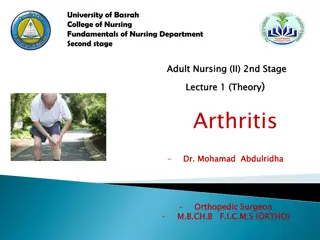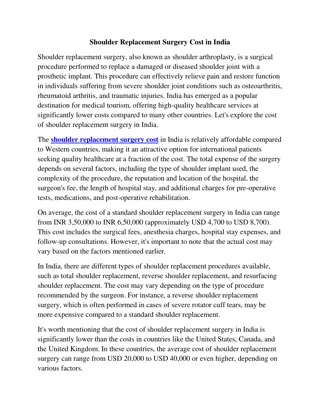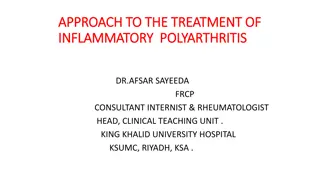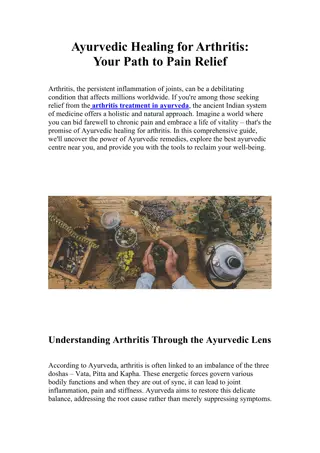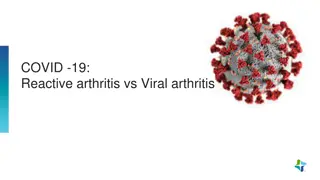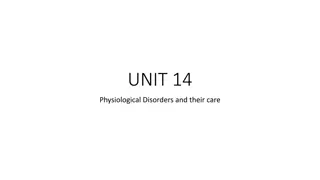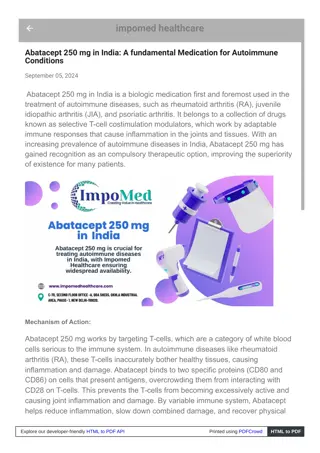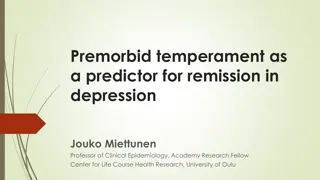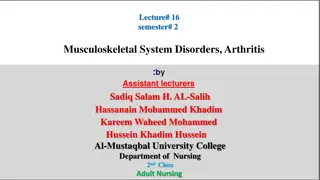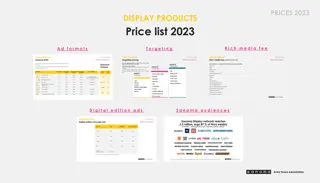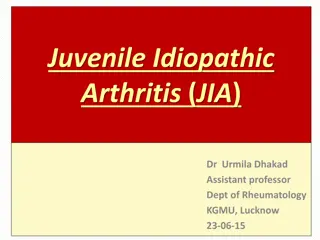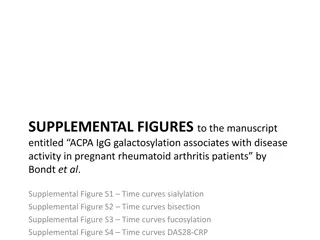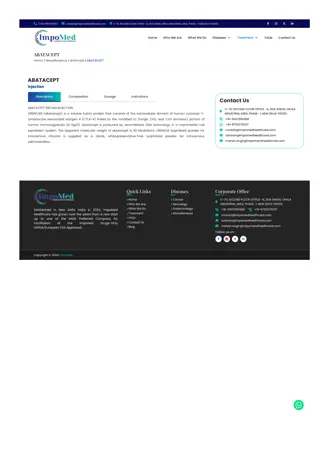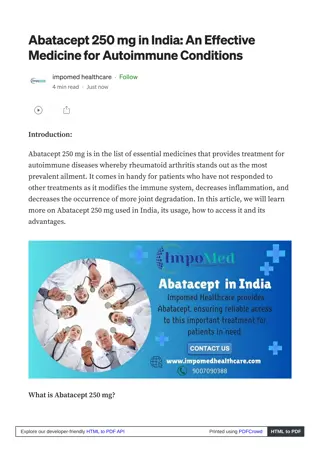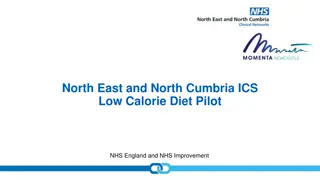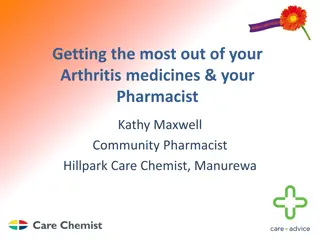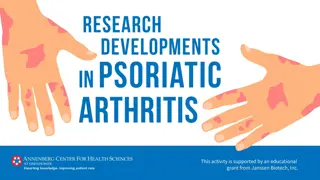Impact of Targeting Remission in Rheumatoid Arthritis
Study examines the impact of sustained remission versus low disease activity on 10-year severity outcomes in rheumatoid arthritis patients. Results suggest remission as a superior target for improved long-term outcomes.
Download Presentation

Please find below an Image/Link to download the presentation.
The content on the website is provided AS IS for your information and personal use only. It may not be sold, licensed, or shared on other websites without obtaining consent from the author.If you encounter any issues during the download, it is possible that the publisher has removed the file from their server.
You are allowed to download the files provided on this website for personal or commercial use, subject to the condition that they are used lawfully. All files are the property of their respective owners.
The content on the website is provided AS IS for your information and personal use only. It may not be sold, licensed, or shared on other websites without obtaining consent from the author.
E N D
Presentation Transcript
Impact of Targeting Remission or Low Disease Activity on 10-year Severity in Rheumatoid Arthritis: Data from ESPOIR Cohort Dupont J, et al. Dupont J, et al. https://acrabstracts.org/abstract/impact-of-targeting-remission-or-low-disease-activity-on-10-year-severity-in-rheumatoid-arthritis-data-from-espoir-cohort/
Study Design and Methods Study Design and Methods Objective: Compare 10-year severity outcomes in patients with RA who have sustained remission vs patients with low disease activity Patients 813 patients with DMARD-na ve early RA DMARD, disease-modifying antirheumatic drug; RA, rheumatoid arthritis
Study Design and Methods Study Design and Methods (continued) Outcomes Remission: SDAI 3.3 or DAS28 <2.6 Low disease activity: 3.3 < SDAI 11 or 2.6 DAS28 3.2 Radiographs centrally scored using modified Total Sharp Score At each visit: Health Assessment Questionnaire completed RA orthopedic procedures documented Patients categorized into 3 groups 1: SDAI remission 2: SDAI low disease activity 3: moderate or high disease activity Patients with unstable disease activity over time were excluded (continued) DAS28, Disease Activity Score- 28 joints; SDAI, Simple Disease Activity Index
Results Summary Results Summary N (% of total) Group 1 (Remission) Group 2 (Low disease activity) SDAI 48 (9.2%) 135 (25.8%) DAS28 79 (14.9%) 53 (10.1%) 10-y structural progression significantly lower in: SDAI-remission vs SDAI-LDA DAS28-remission vs DAS28-LDA Mean 10-y HAQ score significantly lower in: SDAI-remission vs SDAI-LDA DAS28-remission vs DAS28-LDA Orthopedic procedure SDAI-remission: 3/48 (6.3%) SDAI-LDA: 14/135 (10.4%) LDA, low disease activity
Faculty Commentary Faculty Commentary Remission is a better target than low disease activity as evidenced by significantly improved 10-year outcomes as measured by function and structural preservation SDAI is superior to DAS28 for patient management
Implications for Clinical Practice Implications for Clinical Practice Currently, clinicians often do not use validated metrics to assess treatment response Those who do often use DAS28 or RAPID3 Results support ACR and EULAR recommendation for treat-to-target approach using SDAI or Boolean remission to assess treatment response Implementation of study findings will result in more patients having much improved long-term outcomes Unanswered question: Generalizability to entire RA population is unknown but assumed
Long-term Safety and Efficacy of Sarilumab Over 5 Years in Patients With Rheumatoid Arthritis Refractory to Tumor Necrosis Factor Inhibitors Fleischmann R, et al. Fleischmann R, et al. https://acrabstracts.org/abstract/long-term-safety-and-efficacy-of-sarilumab-over-5-years-in-patients-with-rheumatoid-arthritis-refractory-to-tumor-necrosis-factor- inhibitors/
Study Design and Methods Study Design and Methods Objective: Assess the long-term safety and efficacy of the IL-6 receptor inhibitor sarilumab in combination with conventional synthetic DMARD therapy Patients 546 randomized to 24-wk TARGET trial 454 continued onto the extension phase (EXTEND) TARGET (24 wks) EXTEND* Sarilumab 150 mg q2wks Sarilumab 200 mg q2wks (or sarilumab 150 mg q2wks) Sarilumab 200 mg q2wks Placebo *Up to 5 years of follow-up, including TARGET
Results Summary Results Summary 454 patients continued onto the extension phase Treatment in TARGET: 156 placebo q2wks 145 sarilumab 150 mg q2wks 153 sarilumab 200 mg q2wks Mean age 53 y 81% women Mean RA duration 12 y 1655 patient-years of sarilumab exposure 51% had 4 y of exposure LDA, low disease activity
Results Summary Results Summary (continued) (continued) 199 of the 546 originally randomized discontinued treatment over the 5 y 100 (18%) due to TEAE 27 (5%) due to lack of efficacy 68 (13%) for other reasons Incidence rates of TEAEs Overall: 160/100 patient-years Serious: 10/100 patient-years Led to treatment discontinuation: 8/100 patient-years Led to death: 0.3/100 patient-years Causes of death: septic shock, acute pulmonary edema, myocardial infarction, pneumonia, metastatic gallbladder cancer TEAE, treatment-emergent adverse event
Results Summary Results Summary (continued) (continued) Most common AEs Infection: 58 events/100 patient-years Injection site reaction: 22 events/100 patient-years Leukopenia: 18 events/100 patient-years Neutropenia: 15 events/100 patient-years Grade 3/4: 74 patients (14%); normalized on treatment in 65% Efficacy maintained over the 5 y CDAI score from TARGET baseline: -31 15
Faculty Commentary Faculty Commentary Patients who initially do well with sarilumab without significant toxicity are likely to maintain benefit long-term
Implications for Clinical Practice Implications for Clinical Practice If a patient is treated-to-target with sarilumab, switching to a different medication may not be necessary over the long term If a patient develops toxicity to sarilumab, lowering the dose may maintain efficacy and resolve toxicity Study findings provide an understanding of the long-term benefits and risks of sarilumab Unanswered questions: Why do some patients lose efficacy or develop safety issues over time? How can we predict who will lose efficacy and who will develop toxicity?
Safety Profile of Baricitinib for the Treatment of Rheumatoid Arthritis up to 8.4 years: An Updated Integrated Safety Analysis Winthrop K, et al. Winthrop K, et al. https://acrabstracts.org/abstract/safety-profile-of-baricitinib-for-the-treatment-of-rheumatoid-arthritis-up-to-8-4-years-an-updated-integrated-safety-analysis/
Study Design and Methods Study Design and Methods Objective: Update the safety profile of the Janus kinase inhibitor baricitinib with data up to 8.4 y of treatment Database included 1 phase 1b trial 3 phase 2 trials 5 phase 3 trials 1 ongoing long-term extension trial All patients who received 1 dose of baricitinib
Results Summary Results Summary 3770 patients received baricitinib totaling 13,148 patient-years of exposure Time of exposure: Median 4.2 y Maximum: 8.4 y
Results Summary Results Summary (continued) (continued) Adverse Event Events/100 patient-years Treatment-emergent 25.8 Serious 7.2 Permanent discontinuation 4.8 Herpes zoster 3.0 Serious infection Age <65 y Age 65 y 2.7 2.1 4.8 DVT Baricitinib 2 mg Baricitinib 4 mg 0.3 0.4 0.3 PE Baricitinib 2 mg Baricitinib 4 mg 0.2 0.3 0.3 DVT/PE Baricitinib 2 mg Baricitinib 4 mg 0.5 0.5 0.5 DVT, deep vein thrombosis; MACE, major adverse cardiovascular event; NMSC, nonmelanoma skin cancer; PE, pulmonary embolism
Results Summary Results Summary (continued) (continued) Rate of serious infection Baricitinib 4 mg placebo Rates remained stable over time DVT/PE MACE NMSC Incidence rates of individual AEs consistent with previous analyses DVT, deep vein thrombosis; MACE, major adverse cardiovascular event; NMSC, nonmelanoma skin cancer
Faculty Commentary Faculty Commentary Similar rates of VTE in baricitinib 2 mg and 4 mg groups raise the questions: If FDA did not approve 4 mg dose because of VTEs, why was the 2 mg dose approved? If the 2 mg dose has an acceptable VTE risk (similar to other drugs), why isn t the risk with the 4 mg dose acceptable? More infections and serious infections occurred in patients age >65 y whether treated with baricitinib or placebo Need to carefully monitor for infections in patients age > 65 y After 8 y of follow-up, there are no new safety concerns
Implications for Clinical Practice Implications for Clinical Practice Study findings provide reassurance in the long-term safety of baricitinib Unanswered questions: Is there a difference between baricitinib 2 mg and 4 mg with respect to incidence rates of other safety events? If the incidence rates are similar, and the 4 mg dose is somewhat more effective, why is the 4 mg dose not approved? why are clinicians limited to using baricitinib in the bDMARD-failure population?


